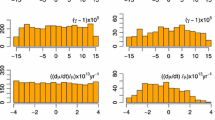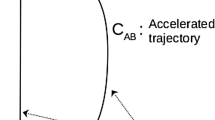Abstract
The JPL planetary and lunar ephemerides – DE200/LE200, DE403/LE403, DE405/LE405 and the planetary and lunar ephemerides, EPM87, EPM98, and EPM2000, constructed in the Institute of Applied Astronomy of RAS are described. Common properties and differences of the various ephemerides are given. Graphical comparisons of the DE ephemerides with each other and with the EPM ephemerides are presented. A fairly good agreement of planetary orbits is between DE403, DE405 and EPM98, EPM2000, respectively, over the interval of 120 years (1886–2006) covered by EPM98 and EPM2000. Some differences are explained by a slight disagreement in representing the orbits of Ceres, Pallas, and Vesta as they affect the planets. The accurate radar observations of planets and spacecraft make it possible not only to improve the orbital elements of planets but to determine a broad set of astronomical constants as well: km/AU, parameters of Mars’ rotation including its precessional rate, the masses of Jupiter, Ceres, Pallas, and Vesta, relativistic parameters of the PPN formalism, the variability of the gravitational constant G. These have been obtained in the fitting process of the DE405 and EPM2000 ephemerides to observational data, including nearly 80000 American and Russian radar observations of planets (1961–1997), ranging and doppler to the Viking and Pathfinder land ers, and other miscellaneous measurements from various sources and spacecraft.
Similar content being viewed by others
References
Akim, Eh. L. and Stepanianz, V. A.: 1977, ‘Numerical theory of motion of the Earth and Venus derived from data of radar observations and optical satellites Venus 9 and Venus 10’, Dokl. AN SSSR 233(3), 314–317 (in Russian).
Akim, Eh. L., Brumberg, V. A., Kislik, M. D., Koljuka, Yu. F., Krasinsky, G. A., Pitjeva, E. V., Shiskov, V. A., Stepanianz, V. A., Sveshnikov, M. L. and Tikhonov, V. F.: 1986, ‘A relativistic theory of motion of inner planets’, in: J. Kovalevsky and V. A. Brumberg (eds), Proceedings of the IAU Symp. N 114, Relativity in Celestial Mechanics and Astrometry, Kluwer, Dordrecht, pp. 63–68.
Aleshkina, E. Yu., Krasinsky, G. A. and Vasilyev, M. V.: 1997, ‘Analysis of LLR data by the program system ERA’, in: I. M. Wytrzyszczak,J. H. Lieske and R. A. Feldman (eds), Proceedings of the IAU Coll. 165, Dynamics and Astrometry of Natural and Artificial Celestial Bodies, Kluwer, Dordrecht, pp. 227–238.
Aleshkina, E. Yu., Krasinsky, G. A. and Vasilyev, M. V.: 2000, ‘Construction of the numerical theory of rotation and orbital motion of the moon taking into account the tidal effects from LLR observations’, in: Abstract Book of the Conference Astrometry, Geodynamics and Celestial Mechanics at the Turn of XXIth Century, 19-23 June, St.-Petersburg, pp. 235–236 (in Russian).
Anderson, J. D., Jurgens, R. F., Lau, E. L. and Slade, M. A.: 1996, ‘Shape and orientation ofMercury from radar ranging data’, Icarus 124, 690–697.
Ash, M. E., Shapiro, I. I. and Smith, W. B.: 1967, ‘Astronomical constants and planetary ephemerides deduced from radar and optical observations’, Astron. J. 72, 332–350.
Brouwer, D.: 1952, ‘A study of the changes in the rate of rotation of the Earth’, Astron. J. 57(1201), 125–146.
Brumberg, V. A.: 1972, Relativistic Celestial Mechanics, Izdatel'stvo ‘Nauka’, Moskva (in Russian).
Eckert, W. J., Brouwer, D. and Clemence, G. M.: 1951, ‘Coordinates of the five outer planets 1653-2060’, Astron. Pap. 12.
Ephemerides of Minor Planets for 1992: 1991, Izdatel'stvo ‘Nauka’, Yu. Batrakov (ed.), Leningrad.
Eroshkin, G. I., Glebova, N. I. and Fursenko, M. A.: 1992, Supplement to the Astronomical Almanac, ITA RAS, St. Petersburg, 27-28A (in Russian).
Everhart, F.: 1974, ‘Implicit single-sequence methods for integrating orbits’, Celest. Mech. 10, 35–36.
Folkner, W. M., Charlot, P., Finger, M. H., Williams, J. G., Sovers, O. J., Newhall XX and Stand ish, E. M.: 1994, ‘Determination of the extragalactic-planetary frame tie from joint analysis of radio interferometric and lunar laser ranging measurements’, Astron. Astroph. 287, 279–289.
Folkner, W. M., Yoder, C. F., Yuan, D. N., Stand ish, E.M. and Preston, R. A.: 1997, ‘Interior structure and seasonal mass redistribution of Mars from radio tracking of Mars Pathfinder’, Science 278, 1749–1752.
Glebova, N. I.: 1984, ‘On the improvement of ephemerides of the inner planets on the basis of optical and radar data treatment for 1960-1980’, Byull. Inst. Teor. Astron. 15(5), 241–250 (in Russian).
Kislik, M. D., Koljuka, Yu. F., Kotel'nikov, V. A., Petrov, G. M. and Tikhonov, V. F.: 1980, ‘A general relativistic theory of motion of the inner planets of the solar system’, Dokl. AN SSSR 255, 545–547 (in Russian).
Konopliv, A. S. and Sjogren, W. L.: 1995, ‘The JPLMars gravity field, Mars 50c, based upon Viking and Mariner 9 doppler tracking data’, in: Publication Jet Propulsion Laboratory 95-3, California Inst. of Tech., Pasadena, CA.
Krasinsky, G. A., Pitjeva, E. V., Sveshnikov, M. L. and Sveshnikova, E. S.: 1981, ‘Some results from a reduction of radar, laser and optical observations of the inner planets and the Moon’, Dokl. AN SSSR 261(6), 1320–1324 (in Russian).
Krasinsky, G. A., Pitjeva, E. V. and Sveshnikov, M. L.: 1982, ‘Improvement of the ephemerides of the inner planets and the Moon using radar measurements, lunar laser observations and meridian observations 1961-1980’, Byull. Inst. Teor. Astron. 15(3), 169–175 (in Russian).
Krasinsky, G. A.: 1985, ‘The obliquity of the ecliptic from occultations of ɛ Geminorum by Mars (1976 y.) and α Leonis by Venus (1959 y.)’, Byull. Inst. Teor. Astron. 15(8), 440–448 (in Russian).
Krasinsky, G. A., Saramonova, E. Yu., Sveshnikov, M. L. and Sveshnikova, E. S.: 1985, Universal time, lunar tidal deceleration and relativistic effects from observations of transits, eclipses and occultations XVIII-XX centuries, Astron. Astrophys. 145, 90–96.
Krasinsky, G. A., Pitjeva, E. V., Sveshnikov, M. L. and Chunajeva, L. I.: 1993, ‘The motion of major planets from observations 1769-1988 and some astronomical constants’, Celest. Mech. & Dyn. Astr. 55, 1–23.
Krasinsky, G. A. and Vasilyev, M. V.: 1997, ‘Universal programming system ERA for high precision applications of dynamic and ephemeris astronomy’, in: I. M. Wytrzyszczak,J. H. Lieske and R. A. Feldman (eds), Proceedings of the IAU Coll. 165, Dynamics and Astrometry of Natural and Artificial Celestial Bodies, Kluwer, Dordrecht, pp. 239–244.
Newhall XX,Stand ish, E. M. Jr. and Williams, J. G.: 1983, ‘DE102: a numerically integrated ephemerides of the Moon and planets spanning forty-four centuries’, Astron. Astrophys. 125, 150–167.
Oesterwinter, C. and Cohen, Ch. J.: 1972, ‘New orbital elements for Moon and planets’, Celest. Mech. 5(3), 317–395.
Pitjeva, E. V.: 1993, ‘Experimental testing of relativistic effects, variability of the gravitational constant and topography of Mercury surface from radar observations 1964-1989’, Celest. Mech. & Dyn. Astr. 55, 313–321.
Pitjeva, E. V.: 1997, ‘The ephemerides of the inner planets from spacecraft range data and radar observations 1961-1995’, in: I. M. Wytrzyszczak,J. H. Lieske and R. A. Feldman (ed s), Proceedings of the IAU Coll. 165, Dynamics and Astrometry of Natural and Artificial Celestial Bodies, Kluwer, Dordrecht, pp. 251–256.
Pitjeva, E. V.: 1998, ‘The new numerical theory of the planets and Moon EPM98 and its comparison with the JPL ephemerides DE403’, in: Proceedings of the IAA RAS, St.-Petersburg 3, 5–23 (in Russian).
Pitjeva, E. V.: 1999, ‘Study of Mars dynamics from analysis of Viking and Pathfinder land er radar data’, in: Proceedings of the IAA RAS, 4, 22–35, St.-Petersburg (in Russian).
Stand ish, E. M., Keesey, M. S. W. and Newhall XX.: 1976, ‘JPL development ephemeris number 96’, JPL Technical Report 32-1603, Pasadena, 1–34.
Stand ish, E. M. Jr.: 1982, ‘Orientation of the JPL ephemerides, DE200/LE200, to the dynamical equinox of J2000’, Astron. Astroph. 114, 297–302.
Stand ish, E.M. and Hellings, R.W.: 1989, ‘A determination of the masses of Ceres, Pallas and Vesta from their perturbations upon the orbit of Mars’, Icarus 80, 326–333.
Stand ish, E. M. Jr.: 1990, ‘The observational basis for JPL's DE200, planetary ephemerides of the Astronomical Almanac’, Astron. Astroph. 233, 252–271.
Stand ish, E. M., Newhall XX,Williams, J. G. and Folkner, W. M.: 1995, ‘JPL planetary and lunar ephemerides, DE403/LE403’, Interoffice Memorand um 314.10-127, 1–22.
Stand ish, E. M.: 1998, ‘JPL planetary and lunar ephemerides, DE405/LE405’, Interoffice Memorand um 312. F-98-048, 1–18.
Stand ish, E.M.: 2000, Dynamical reference frame-current relevance and future prospects, in: K. J. Johnston,D. D. McMarthy,B. J. Luzum and G. H. Kaplan (ed.), Proceedings of the IAU Coll.180, Towards Models and Constants for Sub-Microarcsecond Astrometry, U.S. Naval Observatory, Washington, pp. 120–126.
Williams, J. G.: 1988, ‘Private communication to E. M. Stand ish’.
Williams, J. G.: 1989, ‘Harmonic analysis’, BAAS 21(3), 1009–1010.
Rights and permissions
About this article
Cite this article
Pitjeva, E. Modern Numerical Ephemerides of Planets and the Importance of Ranging Observations for Their Creation. Celestial Mechanics and Dynamical Astronomy 80, 249–271 (2001). https://doi.org/10.1023/A:1012289530641
Issue Date:
DOI: https://doi.org/10.1023/A:1012289530641




